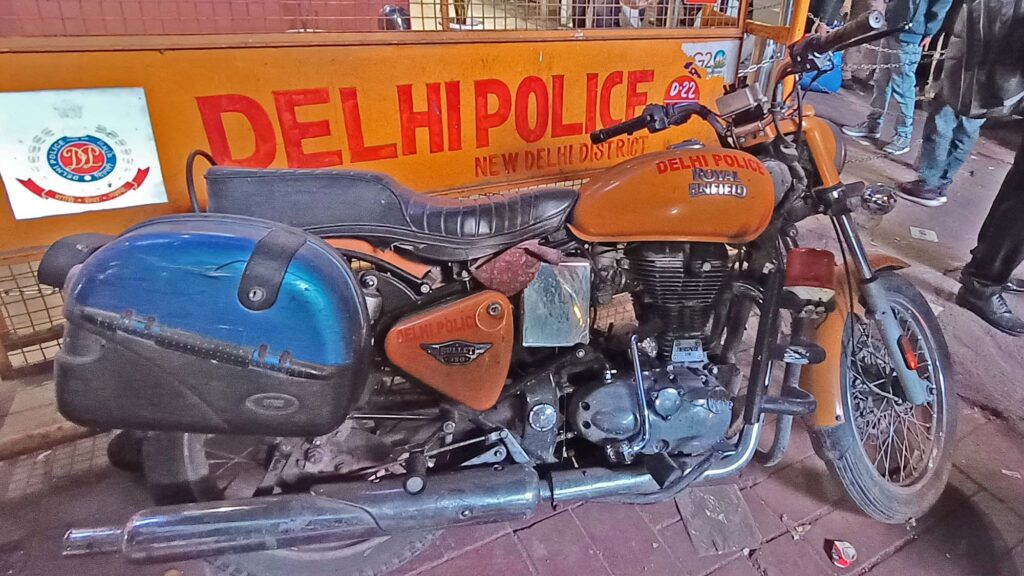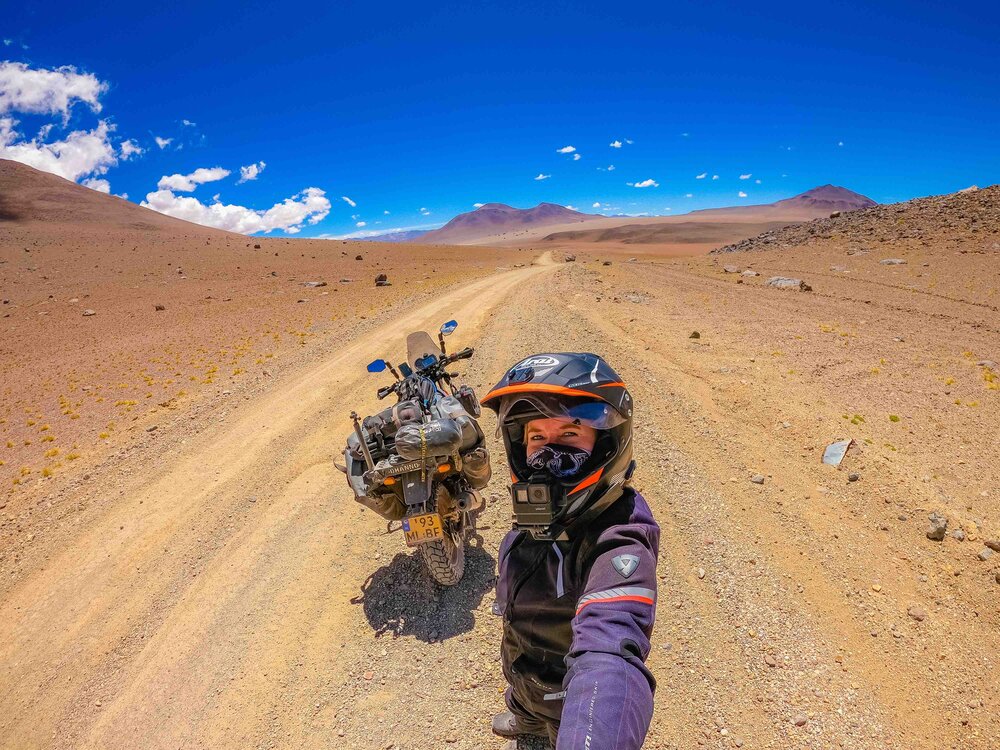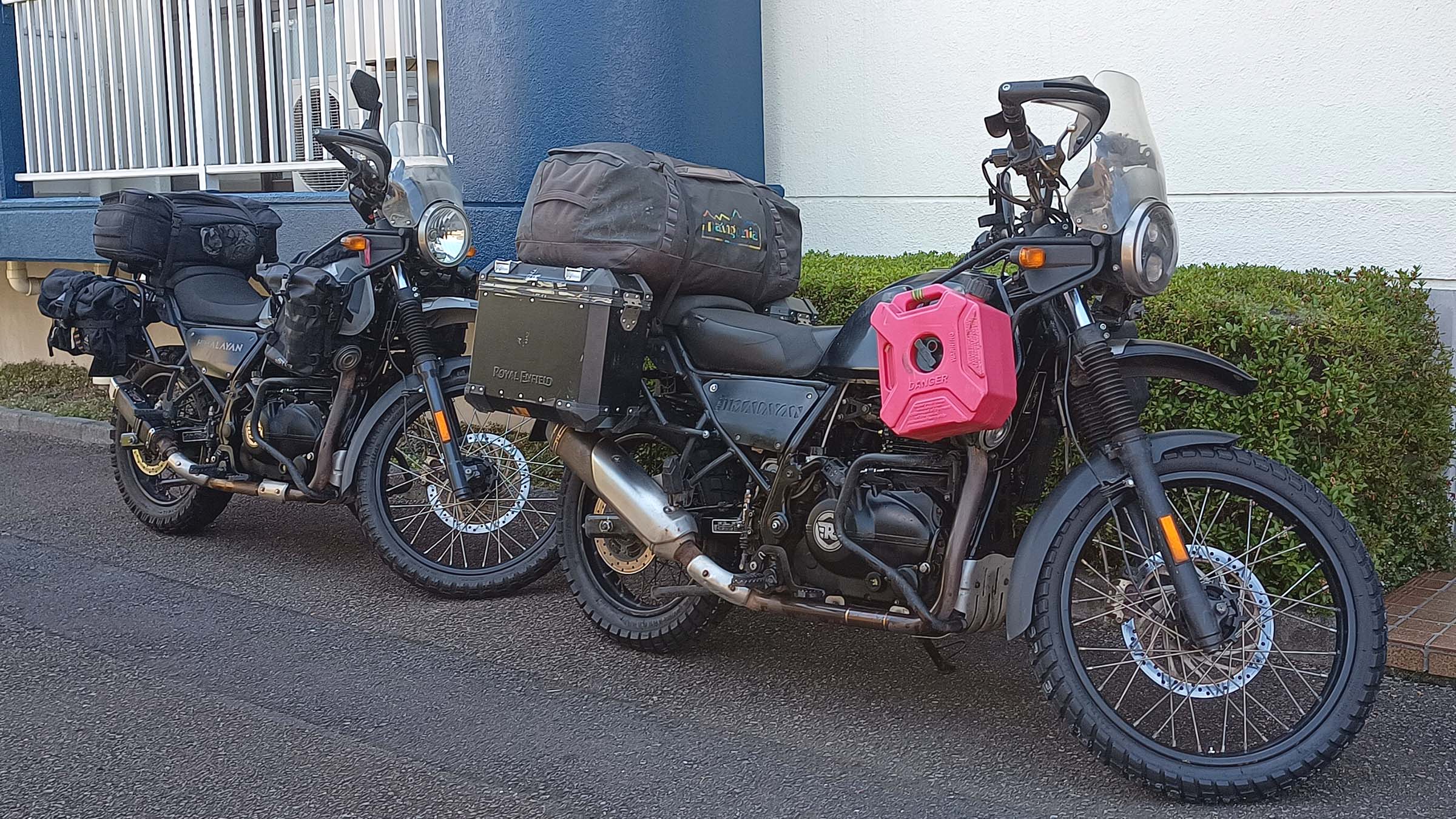Recently, Good Loop received a request for a consultation. A rider who had ridden his Royal Enfield “Himalayan” adventure bike from Europe to Japan wanted to export his beloved bike back to his hometown. Upon seeing the bike that had completed the Great Journey (a long transcontinental journey), the author was honestly surprised to see how the rider had managed to ride such an old-fashioned bike ……. Having usually ridden lightweight, high-powered machines such as the KTM 690, I had a preconceived notion that the Himalayan was retro and unpowered. However, when I actually test rode the bike, I realized that it had a much more unique appeal than I had imagined. The following is an objective and passionate introduction to the Himalayan’s charms for riders who aspire to the Great Journey.
The Royal Enfield Himalayan is an authentic dual-purpose model with a single-cylinder engine that was introduced in 2016. This 180-degree turnaround by the venerable Indian manufacturer, which had previously focused on the classics, resulted in a simple, rugged style that is the polar opposite of heavy-duty adventure bikes that rely on excessive electronic controls. With an affordable price tag, low maintenance costs, a full range of factory accessories, and a well-thought-out luggage system for safe loading, it initially attracted a great deal of attention. After the initial buzz died down, riders began to buy the bike and take it on long trips, and their stories are the real testament to its reputation. In this article, we explore the Himalayan’s appeal and realistic performance for riders who are interested in the Great Journey – that is, global overland travel – and the experiences of those who have actually taken the bike on transcontinental journeys.
Why India Loves It and the World is Watching
An essential part of the Himalayan story is its immense popularity in India, where it originated. Today, Royal Enfield is based in India and boasts one of the world’s top shares in the market for classic mid-engined motorcycles. The Himalayan, in particular, has established itself as the “popular vehicle for adventure touring” in India and has been enthusiastically accepted by Indian riders since its launch. During my own travels in India, I was surprised to see Royal Enfield motorcycles everywhere from the streets to the foothills of the Himalayas. In fact, the Himalayan has been so successful in the Indian market that it has become one of the national bikes, and in recent years its reputation has spread abroad as well.

The Himalayan is loved so much because, as mentioned above, it is a “life-size” adventure bike that is comfortable enough to ride long distances without getting tired and capable of tackling rough terrain, yet affordable enough to be affordable. The simple, easy-to-use design without being too sophisticated matches the road conditions in India and makes many riders feel as if they can make the trip themselves. In fact, Royal Enfield’s own Himalayan touring events (such as the Himalayan Odyssey) attract many participants from home and abroad, and the Himalayan is highly regarded as a friendly bike that gives riders “a chance to embark on an adventure.
From India to Europe: Itchy Boots’ 36,000km Adventure
Dutch female rider Noralee Sphoonmaker (nicknamed Itchy Boots) bought a Himalayan in India and set out on a journey that took her from North India to the European Netherlands via Southeast Asia. She covered 25 countries and 36,000 km in eight and a half months, and her nickname “Itchy Boots” has become widely known among adventure riders. Noralee herself says that she “never had any major breakdowns during the trip,” but that does not mean that there were no minor problems. For example, he proudly recalls that he burned out his clutch plate on a mountain road in Iran after 17,000 km, but fortunately he had a spare and was able to replace it easily by himself. He was in Kazakhstan at the time of the second replacement, but was able to find a compatible bearing on the local market, which saved his life. He was in Kazakhstan at the time of the second replacement. As for the tires, he felt that the original Indian tires (made by CEAT) were useless due to their weak grip, so he replaced them with new ones after 1,100 km and continued his trip with his favorite Pirelli MT60 tires (MT60 tires are standard equipment on Himalayans for the US and Europe from the beginning). He also cited other complaints such as “the seat is too soft,” “the windscreen is too low,” and “the main stand takes away the minimum ground clearance,” but he said “that’s about it, not a big problem.

Noralee also paid careful attention to maintenance, and achieved zero serious breakdowns after traveling 40,000 km over rough roads. She also made it a point to replace parts as soon as possible before they break, and to change the engine oil every 3,000 km, even in remote areas where inferior oil is the only thing available. Her reasons for choosing the Himalayan were clear: “It is inexpensive. She says she can travel just as well without spending a fortune on an expensive adventure vehicle, and she can do more adventures with the money she saves. Also important was that it was “tough and easy to handle. He has tipped it over many times, but it was not so heavy that he could not get it up by himself. He felt that it would not break down in any remote area and was easy to maintain. Because of its low-tech construction that does not rely on electronic control, “even a mechanic in a back alley on the road would not be afraid to open the engine,” which was a great source of reassurance on the transcontinental journey. On the other hand, it was not suited for trips that mainly involved high-speed cruising, and he said, “I certainly want more power. If you drive only on highways, you will be disappointed,” he said frankly. Nevertheless, she says, “If I want to go on back roads, I have no problem at all enjoying the current power output.” In fact, she drove this car all the way from the Himalayas to the Middle East and Europe on a long local road trip.
Young British Rider Circumnavigates the World in the Himalayan

This British rider named Jack left London in July 2019 at the age of 21. He will cross the European continent, passing through the Balkans to Turkey and then on to Central Asia. He crossed the Caspian Sea by ferry and rode from Turkmenistan to Tajikistan and Kyrgyzstan, taking on the legendary Pamir Plateau route. While struggling with cumbersome travel procedures (so-called “red tape”) when crossing China, they reached Laos, Thailand, and Malaysia in Southeast Asia. In the latter half of the trip, we also crossed the Australian continent. In midsummer in Australia, the riders were exposed to the fury of forest fires, which were said to be the worst in decades, and they pushed on through the scorching air from the Nullabor Plains to Sydney. The conditions were so severe that the rider himself had to go through the blazing sun with water pouring from his head, but the Himalayan remained his partner throughout the journey. He then traveled to South America, spending a month traversing the Patagonia region, and from Argentina, he traveled north to Bolivia via the famous Ruta 40 route along the Andes Mountains. He hurriedly headed to Peru. He hurried to Peru and slipped into Cusco, the ancient capital of the Inca Empire, but soon after, a nationwide lockdown was issued, forcing him to stay behind. He was forced to stay in Cusco for about 9 months, but he never gave up and resumed his journey at the end of 2020. With the help of the British Embassy, he traveled through Peru, Ecuador, Colombia, and Central America, and then north to Mexico. Skipping the North American continent (the United States) due to circumstances, I returned to Europe first, and in 2021, I ran the final leg of the journey where I joined my father and successfully made it back alive to London, completing the round-the-world trip. In terms of Globe coordinates, this itinerary was a complete circumnavigation of the globe, and the Himalayan team supported him throughout the two years of his challenge.
During Jack’s epic journey, he was fortunate not to hear any anecdotes of serious mechanical problems with his Himalayan. The Himalayan, which he purchased used before his departure, was carefully equipped and well maintained to withstand the long haul. He had a bizarre pre-departure accident in which he was thrown forward on the handlebars (the front wheel lifted and fell over in Dover, England, just before departure), but he escaped with minor injuries and was able to get the machine back up and continue on his journey. Although the total distance covered has not been made public, the route spanned all but six continents except Africa and North America, proving that the Himalayan can endure an endurance race around the world.
Vietnamese Adventurers Talk about the Himalayans

The Himalayan is also being supported in Southeast Asia as “just the right partner. Stewart, who runs a tour company in Phuong Nha, central Vietnam, saw the Himalayan after it was launched and immediately decided to purchase one, saying, “It’s perfect for what I need it for. He has driven more than 4,000 km on the Himalayan so far and says that it has “driven me all over the road with no problems,” including on unpaved timber haul roads and jungle dirt tracks. He has heard some people say that the seat is too soft, but he feels that “the softness is perfect” because he himself is a thin man with little cushioning. In fact, he jokingly praises the Himalayan as a “butt savior” because it is so comfortable that he can “ride all day long,” whereas other dual-purpose bikes tend to suffer from “a hard seat like plywood. He also trusts the Himalayan’s neutral handling, which he says allows him to follow his target line on both pavement and dirt roads, and to turn steadily in corners as if he were sticking to the ground. The weight is not excessive, either,” he says, “and the bike just goes where you want it to go. He says the Himalayan is the ideal partner for enjoying Vietnam’s spectacular routes (e.g., the Ho Chi Minh Trail).
Meanwhile, Donovan (nicknamed Hawkmoon), also a tour guide and instructor in Vietnam, chose the Himalayan after having ridden numerous motorcycles. I took the plunge and bought a Himalayan four months ago, and I’ve never once regretted it. It’s the best bike for riding in Vietnam,” he asserts, adding that he arrived at this bike after considering the need for a bike with a high average score in all regions of the country. In Vietnam, road conditions can change rapidly over the course of a short trip, but the Himalayan “is comfortable on long tours and off-road sections, and handles all types of road conditions well,” he says. He is also impressed with the bike’s practicality as a travel bike, as it comes with a standard cargo frame that securely holds luggage in the front and rear, and he has even built himself an additional side rack and attached waterproof saddlebags. The only light he had to replace with a xenon lamp because it was too dim, but other than that, the bike has required no modifications, and in terms of style, he is happy with the way it looks and sounds, saying, “I love the way it looks and sounds.
Value found by veterans in Australia
David, an experienced rider living in Australia, had been riding on-road bikes for many years, but when adventure travel became popular among his friends, he realized that he wanted an adventure bike as well. However, he had always felt uncomfortable with the high seat height and weight of the mainstream large models, and this became the deciding factor. At the same time, he had the opportunity to ride several Royal Enfield models, and his experience touring in Rajasthan (India) on a 500cc Bullet helped him to become interested in the company’s new Himalayan. After gathering thorough information, he learned that a local Australian magazine was testing the Himalayan for an extended period of time, and he decided to purchase the vehicle after the tests were completed. He bought a used Himalayan with low mileage but with many practical customizations, such as replacing the tires with good quality off-road tires. For example, he replaced the tires with high-quality off-road tires, installed hand guards, added a DIN-standard power socket, added a tank bag and side bags, and installed LED indicator lights. After the purchase, he himself only added a wool seat cover, reattached the side stand that had loosened and nearly fallen off while riding, and repaired and replaced the stator coil (alternator) that had burned out and was unable to generate power. The stator coil burnout is said to be a problem sometimes seen in early Himalayan models, but with proper replacement of parts, it did not become a serious problem, and no other problems with major parts such as the engine or clutch have occurred.
David says that many of his friends drive high-end adventure models such as large-displacement BMWs and Triumphs. However, he is well aware of the Himalayan’s modest dynamic capabilities and laughs, “On the highway, I just let my friends go first. The Himalayan is most comfortable at cruising speeds of 80 to 90 kilometers per hour, and is not good at going faster than that. Therefore, on long straight roads, he inevitably lags behind larger vehicles, but he confidently states, “If I go on dirt roads instead, I’m the one who gets the last laugh. So while the heavy big machines struggle on the rough roads, he can catch up with his nimble Himalayan. In fact, he describes his time with the Himalayan with satisfaction, saying, “The 411cc adventure bike life is great. The small displacement allows the bike to run anywhere on regular gasoline with good fuel economy and enough carrying capacity. He also feels that the ease with which he can drive the bike on tough roads without hesitation makes the trip itself more freeing. He told us about his dream for his next adventure: “Someday, I want to circumnavigate the Australian continent on a Himalayan and prove that it is possible to do so on this bike.
Conclusion: As a Great Journey Oriented Sidekick
What emerges from the stories of riders who have traveled around the world on Himalayans is the bike’s solid reliability and familiarity. Although it is not a high-speed, long-distance machine, its simple construction and resistance to breakage, as well as a mechanism that can be easily adapted locally in the event of a problem, are major reassurances for travelers who ride alone in unknown terrain. In fact, Noralee has driven nearly 40,000 km without any serious problems, even during the most arduous off-road driving, and has done all the necessary maintenance on her own or with the help of local repairmen. The ease of use and comfort that many riders have pointed out are also important points that support the Great Journey. The seat, which does not tire easily even after long rides, the engine’s mid- to low-speed torque-driven characteristics, and the vehicle’s light weight (approximately 191 kg) compared to larger adventurers, give riders plenty of room to maneuver, not only on paved roads but also on unpaved roads. The Himalayan is not a bike blessed with a lot of horsepower, but its simple power sometimes keeps the pace of the journey leisurely, giving the rider the freedom to enjoy the scenery and the encounters that result. As Noralee said, “This bike is good enough for me, and it is this bike that makes me want to go on a trip.” The Himalayan is a bike that teaches the joy of traveling the world in a different approach than expensive state-of-the-art machines. For Great Journey-oriented riders, the Himalayan’s down-to-earth appeal is as rich and profound as the journey itself.
Reference: Stories of riders who have ridden Himalayans around the world.
- Four Adventure Bikers Share their Experience of Life with a Royal Enfield Himalayan
- On the ODO: 20.000 km – When the world stopped spinning
- Circling the Globe on a Royal Enfield Himalayan
and related information.
